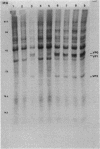Abstract
4',6-Dicyanoflavan (DCF), a new antirhinovirus compound, was shown to inhibit an early event of rhinovirus type 1B replication in HeLa cells. When DCF was present from the beginning of infection or was added no later than the first hour of infection, the compound completely prevented viral RNA and protein synthesis and the virus-induced shutoff of host translation. DCF had no adverse effect either on virus binding to the cell membrane or on virus penetration into cells, whereas it delayed the uncoating kinetics of neutral redencapsidated rhinovirus. DCF also prevented mild acid or thermal inactivation of virus infectivity, although it reversibly interacted with virions. These results suggest that the stabilizing effect of DCF on virion capsid conformation is responsible for uncoating inhibition.
Full text
PDF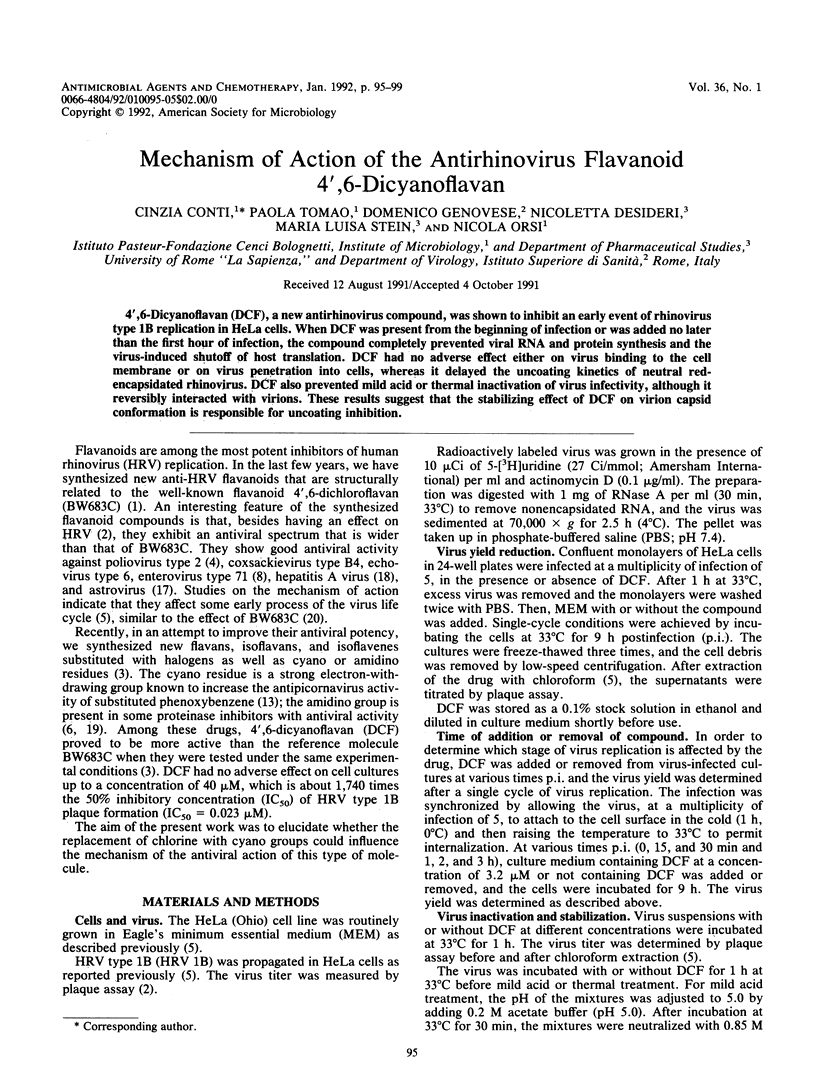
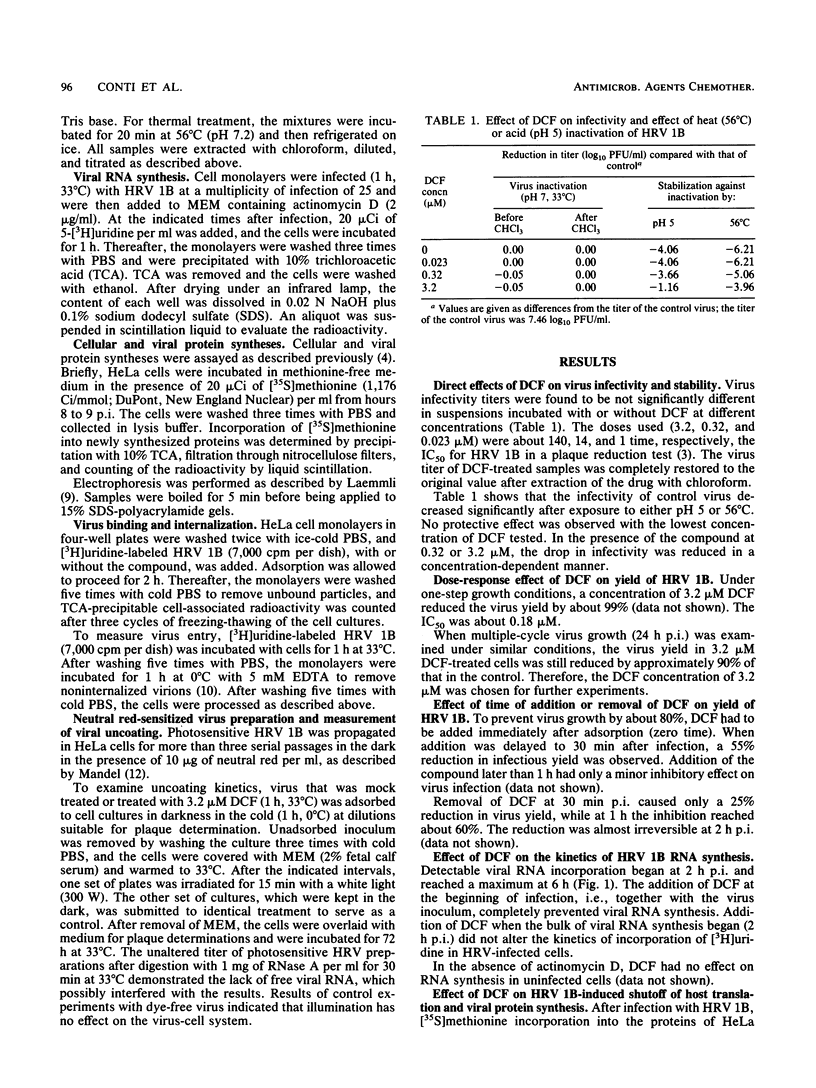
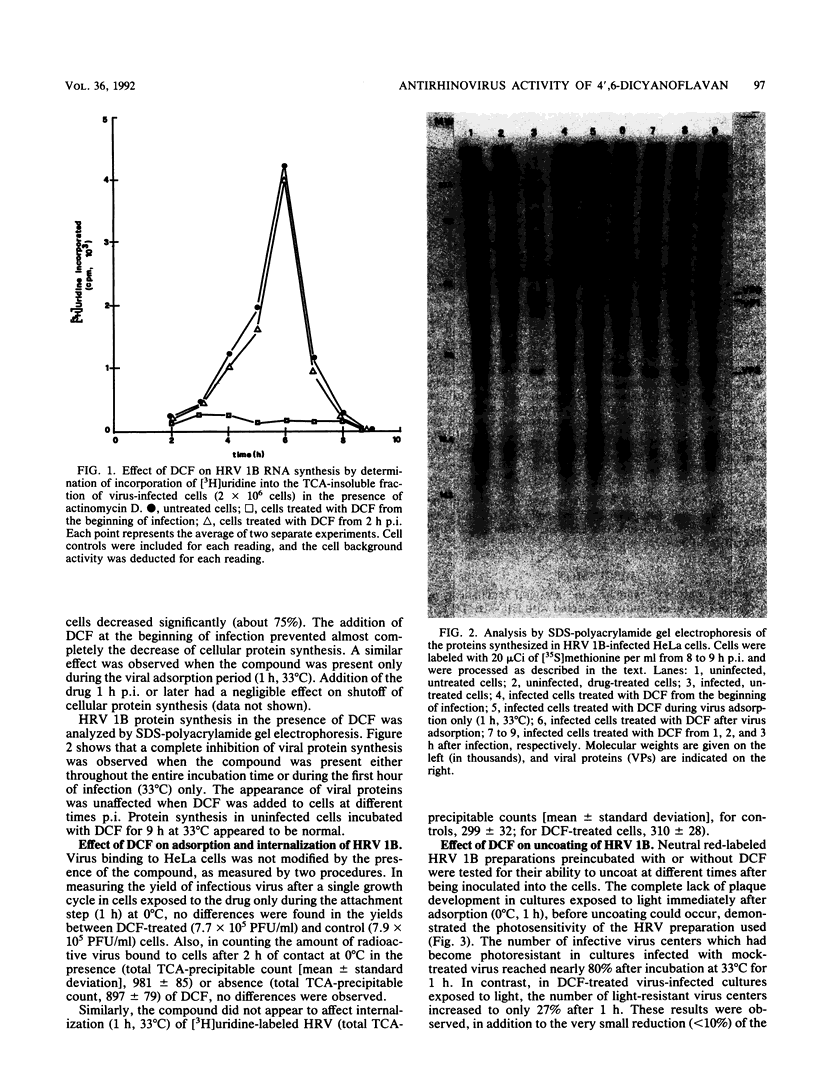
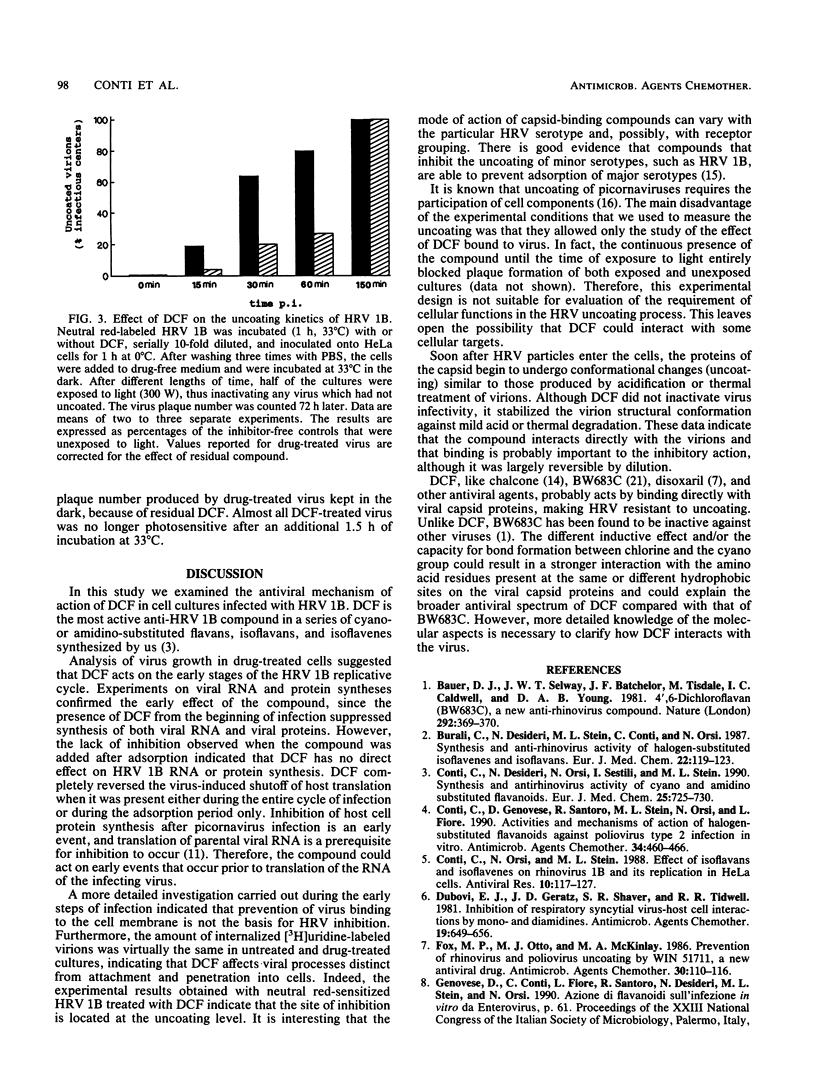
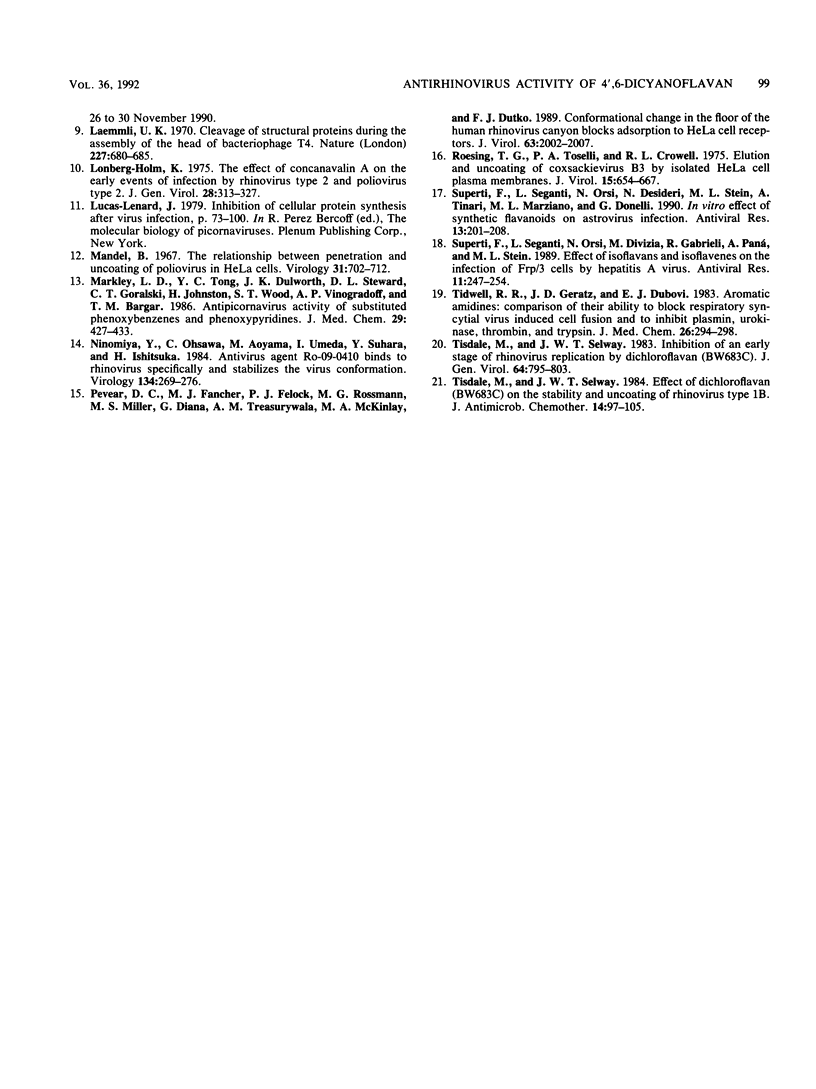
Images in this article
Selected References
These references are in PubMed. This may not be the complete list of references from this article.
- Bauer D. J., Selway J. W., Batchelor J. F., Tisdale M., Caldwell I. C., Young D. A. 4',6-Dichloroflavan (BW683C), a new anti-rhinovirus compound. Nature. 1981 Jul 23;292(5821):369–370. doi: 10.1038/292369a0. [DOI] [PMC free article] [PubMed] [Google Scholar]
- Conti C., Genovese D., Santoro R., Stein M. L., Orsi N., Fiore L. Activities and mechanisms of action of halogen-substituted flavanoids against poliovirus type 2 infection in vitro. Antimicrob Agents Chemother. 1990 Mar;34(3):460–466. doi: 10.1128/aac.34.3.460. [DOI] [PMC free article] [PubMed] [Google Scholar]
- Conti C., Orsi N., Stein M. L. Effect of isoflavans and isoflavenes on rhinovirus 1B and its replication in HeLa cells. Antiviral Res. 1988 Nov;10(1-3):117–127. doi: 10.1016/0166-3542(88)90020-4. [DOI] [PubMed] [Google Scholar]
- Dubovi E. J., Geratz J. D., Shaver S. R., Tidwell R. R. Inhibition of respiratory syncytial virus-host cell interactions by mono- and diamidines. Antimicrob Agents Chemother. 1981 Apr;19(4):649–656. doi: 10.1128/aac.19.4.649. [DOI] [PMC free article] [PubMed] [Google Scholar]
- Fox M. P., Otto M. J., McKinlay M. A. Prevention of rhinovirus and poliovirus uncoating by WIN 51711, a new antiviral drug. Antimicrob Agents Chemother. 1986 Jul;30(1):110–116. doi: 10.1128/aac.30.1.110. [DOI] [PMC free article] [PubMed] [Google Scholar]
- Laemmli U. K. Cleavage of structural proteins during the assembly of the head of bacteriophage T4. Nature. 1970 Aug 15;227(5259):680–685. doi: 10.1038/227680a0. [DOI] [PubMed] [Google Scholar]
- Lonberg-Holm K. The effects of concanavalin A on the early events of infection by rhinovirus type 2 and poliovirus type 2. J Gen Virol. 1975 Sep;28(3):313–327. doi: 10.1099/0022-1317-28-3-313. [DOI] [PubMed] [Google Scholar]
- Mandel B. The relationship between penetration and uncoating of poliovirus in HeLa cells. Virology. 1967 Apr;31(4):702–712. doi: 10.1016/0042-6822(67)90198-5. [DOI] [PubMed] [Google Scholar]
- Markley L. D., Tong Y. C., Dulworth J. K., Steward D. L., Goralski C. T., Johnston H., Wood S. G., Vinogradoff A. P., Bargar T. M. Antipicornavirus activity of substituted phenoxybenzenes and phenoxypyridines. J Med Chem. 1986 Mar;29(3):427–433. doi: 10.1021/jm00153a020. [DOI] [PubMed] [Google Scholar]
- Ninomiya Y., Ohsawa C., Aoyama M., Umeda I., Suhara Y., Ishitsuka H. Antivirus agent, Ro 09-0410, binds to rhinovirus specifically and stabilizes the virus conformation. Virology. 1984 Apr 30;134(2):269–276. doi: 10.1016/0042-6822(84)90296-4. [DOI] [PubMed] [Google Scholar]
- Pevear D. C., Fancher M. J., Felock P. J., Rossmann M. G., Miller M. S., Diana G., Treasurywala A. M., McKinlay M. A., Dutko F. J. Conformational change in the floor of the human rhinovirus canyon blocks adsorption to HeLa cell receptors. J Virol. 1989 May;63(5):2002–2007. doi: 10.1128/jvi.63.5.2002-2007.1989. [DOI] [PMC free article] [PubMed] [Google Scholar]
- Roesing T. G., Toselli P. A., Crowell R. L. Elution and uncoating of Coxsackievirus B3 by isolated HeLa cell plasma membranes. J Virol. 1975 Mar;15(3):654–657. doi: 10.1128/jvi.15.3.654-657.1975. [DOI] [PMC free article] [PubMed] [Google Scholar]
- Superti F., Seganti L., Orsi N., Desideri N., Stein M. L., Tinari A., Marziano M. L., Donelli G. In vitro effect of synthetic flavanoids on astrovirus infection. Antiviral Res. 1990 Apr;13(4):201–208. doi: 10.1016/0166-3542(90)90038-9. [DOI] [PubMed] [Google Scholar]
- Superti F., Seganti L., Orsi N., Divizia M., Gabrieli R., Panà A., Stein M. L. Effect of isoflavans and isoflavenes on the infection of Frp/3 cells by hepatitis A virus. Antiviral Res. 1989 Jun-Jul;11(5-6):247–254. doi: 10.1016/0166-3542(89)90034-x. [DOI] [PubMed] [Google Scholar]
- Tidwell R. R., Geratz J. D., Dubovi E. J. Aromatic amidines: comparison of their ability to block respiratory syncytial virus induced cell fusion and to inhibit plasmin, urokinase, thrombin, and trypsin. J Med Chem. 1983 Feb;26(2):294–298. doi: 10.1021/jm00356a036. [DOI] [PubMed] [Google Scholar]
- Tisdale M., Selway J. W. Effect of dichloroflavan (BW683C) on the stability and uncoating of rhinovirus type 1B. J Antimicrob Chemother. 1984 Aug;14 (Suppl A):97–105. doi: 10.1093/jac/14.suppl_a.97. [DOI] [PubMed] [Google Scholar]
- Tisdale M., Selway J. W. Inhibition of an early stage of rhinovirus replication by dichloroflavan (BW683C). J Gen Virol. 1983 Apr;64(Pt 4):795–803. doi: 10.1099/0022-1317-64-4-795. [DOI] [PubMed] [Google Scholar]



